|

|
Number of versions: 11
Edition: November 12, 2009
|

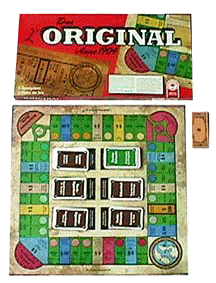 Edition: Das/l'
Original Edition: Das/l'
Original
Publisher: ASS - Leinfelden - 1986
Dimensions of the box: 26.5 x 50.2 cm
The game:
On the lid of this original, bilingual set (German and French) is this
quotation from "Spiele anders als andere" by Sid Sackson of 1981
saying:
"This reproduction of the original document will doubtless recall
memories to anybody who ever played Monopoly. Indeed the way from "Landlord's
Game" to "Monopoly" goes by …. Monopoly. In the early twenties
a game under this name was used already in many university cities on the east
coast of America: there handmade game boards were used with mostly local names
for the properties and a game was played already that a few years later
conquered the world." (Read the book "The
Billion Dollar Monopoly Swindle")
On the back of the box stands:
 "On Januari 5th,
1904 a game was patented at the United States Patent Office under No. 748,626: THE
LANDLORDS GAME, by Lizzie J.Magie: "On Januari 5th,
1904 a game was patented at the United States Patent Office under No. 748,626: THE
LANDLORDS GAME, by Lizzie J.Magie:
To all whom it may concern:
Be it known that I, LIZZIE J.Magie, a citizen of the United States,
residing at Brentwood, in the county of Prince George and State of Maryland,
have invented certain new and useful Improvements in Game - Boards, of which the
following is a specification.
My invention, which I have designated "The landlord's game," relates
to gameboards, and more particularly to games of chance. The object of the game
is to obtain as much wealth or money as possible, the player having the greatest
amount of wealth at the end of the game after a certain predetermined number of
circuits of the board have been made being the winner.
"Das/L'Original" contains the original version of this game
with original board and instructions. However "Das/L'Original" also
contains a modern version of this old economy game with instructions and
board."
With this game people in Europe for the first time got aquainted with the
history of the "famous game". Both the text and the sketches of
the original patent were inserted in each of the instructions of the game
showing clearly that Lizzie J.Magie already played Monopoly in 1904. (See
also "Early Game History - 1903 to 1936").
The differences between the rules of the original and nowadays game are very
interesting:
 |
The 22 properties are not build on but rented, let out and sold. |
 |
The estates in the original game have no names but they have in the
"modern version". |
 |
When an other player lands on an estate you rent he has to pay
rent. Should another lands on that same property he has to pay half of the
rent to the leaseholder and the other half to the other player. |
 |
When you are the owner of 2 adjacent properties the rent triples.
With 3 adjacent properties you earn 4 times the rent for that property. |
 |
There are no Chance nor Community Chest cards but fields where Taxes
for Absolute Necessities have to be payed. |
 |
The 4 stations are not at all lucrative properties. On the contrary,
one has to pay $ 5 each visit. |
 |
GO is called Mother Earth. When you land on or pass by this
beginning-point you'll receive $ 100, because you are supposed to have
performed so much labor upon mother earth for which you receive your wages. |
 |
You pay $50 to the "Public treasury" on the Luxury spaces,
receiving in return a luxury ticket, which counts you $ 60 at the end of the
game. |
 |
To get out of Jail one pays $ 50 as 90 years ago. |
 |
For the light and water franchise you pay but $ 5,
regardless of the number of eyes you have thrown! |
 |
If at any time a player has no money nor properties he must go to the poorhouse
(= the Free Parking space) untill he will be able to finish his round. |
 |
There is a Legacy space where a player get $ 100 cash and a
legacy-ticket with a value of $ 50 at the end of the game. |
 |
A player may borrow from the Bank in amounts of $ 100 of which he only
receives $ 90! Besides he pays $ 5 for each bank mortgage every time
he receives his wages (= passing over Mother Earth). |
 |
One player may borrow from another. However, these individual mortgages
are limited to $ 50 each. |
 |
With the OIL version of the game players can buy drilling rigs,
after it is prooven that there is oil indeed! The player who lands on such a
property pays 10 times the rent! |
The colors of the spaces have the following meaning:
GREEN = estate
GREY = station
YELLOW = light and water franchises
LIGHT BLUE = tax for absolute necessities
DARK BLUE = luxuries
YELLOW with black rim = legacy
RED = No trespassing - Go to jail
The six spaces in the centre of the board are respectively for:
 |
Property cards |
 |
Charters |
 |
Luxuries |
 |
Bank mortgages |
 |
Individual mortgages |
 |
Legacies |
The 4 tokens are aggravation pawns. Of the black pawns are 22 pieces
as drilling rigs. The money consists of simple notes with a value
mention of 1 - 5 - 10 50 or 100.
There is another issue in only German language.
There should have been a lot more of such authentic games (who
were "locally tied"?!) "re-issued"!
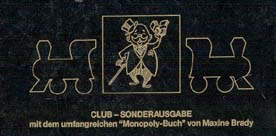 Edition:
Monopoly,
Art.Nr. 032/563122 Edition:
Monopoly,
Art.Nr. 032/563122
Club
Sonderausgabe mit dem umfangreichen
"Monopoly-Buch"
von Maxine Brady.
Publisher: Parker/Tonka/Hasbro Deutschland GmbH - 1992
Dimensions of the box: 26 x 51 cm
The game:
The peculiarity of this Club Sonderausgabe (the picture shows a detail of the
lid) is the fact that this black box contains the German issue of Maxine
Brady's booklet, in a special space of the red
plastic insert. Further are 7 trays in that insert for the banknotes, 1 for the
property cards, 1 for the Ergeinis- and Gemeinschafts cards and 1 for the other
components (so 2 trays less than in the Sonderausgabe (= special edition) of
1961). This is obvious a re-issue of the game of 1961, but there are remarkable
differences.
Now the red Monopoly bar goes diagonal
over the play-field. The fold is parallel to side 1 and 3. The back side of the board
is red.
The banknotes in this issue are of the denominations: DM 20 - 50 - 100 -
500 - 1,000 - 2,000 and 10,000. The Ereigniskarten (=
Chance) as well as
the Gemeinschaftskarten are white, but their back sides have resp. a blue
and pink engine-pattern. The 8
metal tokens are the boat, cannon, wheelbarrow, thimble, shoe, dog, hat
and horse. The hollw plastic houses are green
and do have a chimney, the red hotels
haven't. However, they all have overhanging roofs.
On the bottom of the box is a clear black and white picture of the game board
with all ist component parts.
This edition was also issued in Austria and Switserland.
This set was "Made in Ireland".
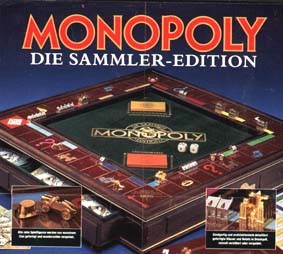 Edition:
Sammler-Edition
(Collector's edition) Edition:
Sammler-Edition
(Collector's edition)
Publisher: Franklin Mint - 1992
Dimensions of the table: 7.5 x 52.5 x 52.5 cm + pedestal
The game:
Without exaggeration this "authorized" issue can be called The Game
of the Games. The board is made of distinguished mahogany
stained hardwood with a green felt-lined
sunken midfield. The printing is in gold. Underneath the playfield is a sliding
drawer for the banker, also green felt-lined.
The drawer has a knob provided with a brass Monopoly game coin. On the other 3
sides of the set is a brass Monopoly plate.
The background of the streets is of the same mahogany
color as the wood. Even the instructions and the "Real Estate
Portfolio" are in this dignified color.
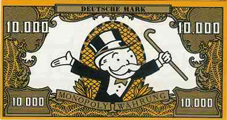 All 10 classic playing tokens are crafted in pewter and embellished with 22
carat gold, amongst them a purse and a hurrycane latern. The architecturally-designed houses and hotels are dycast
and plated with silver and gold.
All 10 classic playing tokens are crafted in pewter and embellished with 22
carat gold, amongst them a purse and a hurrycane latern. The architecturally-designed houses and hotels are dycast
and plated with silver and gold.
Also the banknotes have a luxury appearance and are special made for this
Collector's Edition. The currency is "Deutsche Mark" but with the
remark "Monopoly Währung" (Monopoly currency).
The bills show Mr.Monopoly, with his colored bow tie and walking stick. The number of banknotes is twice as much as usual!
The red Chance and yellow
Community Chest cards have all funny illustrations with Uncle
Pennybags, as usual.
 The
wooden pedestal for
this set contains another 4 drawers for the players to collect their money and
property cards. Finally the set can be covered by a glass plate, to
protect from dust. The
wooden pedestal for
this set contains another 4 drawers for the players to collect their money and
property cards. Finally the set can be covered by a glass plate, to
protect from dust.
The summer-1998-edition of the Franklin Mint catalogue showed the German
set still being available. The prices were:
 | board DM 1250,- (€ 642,30) |
 | pedestal DM 695,- (€ 356,80) |
 | glass cover DM 195,- (€ 99,90) |
 | and the so-called "Miljonaire's chairs" for
the paltry sum of DM 595,- (€ 305,50) per pair. |
 | Should you had some money left you might have bought an "Official Monopoly-clock for Millionaires" at the price
of DM 395,- (€ 202,90). |
Edition: Small
box, Ref. 6951D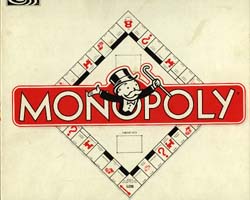
Publisher: Parker Brothers/Tonka/Hasbro
Deutschland GmbH - 1992
Dimensions of the box: 25.5 x 25.5 cm
The game:
Like the game board of this issue is printed on the lid has never been shown
before. Because only two colors have been used some illustratrations do not
correspond to those of the real board. Nevertheles the engines could have been black.
The double folded game board is of solid carton and the play area is blue
green of color. Its back is red.
Monopoly stands diagonally on the midfield in black characters and in a black
rectangle, with there under still the patent-line till 1985. (Compare this
version with the same ref.number of 1993.)
The Chance and Community Chest cards resp. have a blue
and pink locomotive-pattern on the
back side. In the circle on the banknotes stands "Monopoli® -
Monopoly® - Monopol®" and "Copyright 1935 by Parker Brothers
USA". The denominations are resp.: DM 20 -50 - 100 - 500 - 1,000 -2,000 and
10,000. The tokens are plastic pawns. The plastic houses and hotels
do have a roof-edge but no chimney. The dice are red,
with gold pips.
The insert of the inner box is of white plastic and has 5 holes.
These sets were made in Ireland.
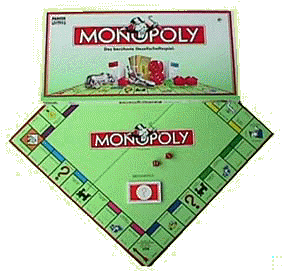 Edition: Standard,
Ref. 06951D1093 Edition: Standard,
Ref. 06951D1093
Publisher: Parker/Tonka/Hasbro Deutschland - 1993
Dimensions of the box: 26 x 51 cm
The game:
Of course the idea of the game hasn't changed in the course of years.
Consequently the streets on the board are not those of the capital, nor of a
number of cities of the country, but very general occuring streets like Turmstrasse,
Hafenstrasse, Münchenerstrasse, Schillerstrasse and Schossallee. However,
since the sets a no longer made in Germany the ß in the German words is
changed into ss.
This set comes from the Irish works, so on the lid the fourth side of
the game board with the collection of attributes on a green
background on top of it. At the bottom of the box is the well-known color
picture of the laughing family that looks more to eachother than to the game.
The back side of the board is red, like the
plastic tray of the inner box. The back of the Ereigniskarten is printed
with a red ?, whereas the Gemeinschaftskarten
are printed with the blue treasure chest.
The banknotes are of class B, i.e.Monopoly money printed in white on
colored background. The 10 tokens are of heavy metal and "made in
China". The plastic houses have a chimney, the hotels have
not.
The price of this game amounted to DM 49.95 (= = € 25.65) July 1997.
Edition: Small box, Ref. 06951D1093
Publisher: Parker/Tonka/Hasbro Deutschland - 1993
Dimensions of the box: 26 x 26 cm
The game:
Also this "small box" version comes from the Irish works with
on the cover the fourth side of the game board with on top of it the collection
of attributes, which differs however from that on the Standard box. The
collection of attributes is now grouped around a blue
pawn and the background is blue as well.
There is no picture on the bottom of the box.
The back of the Ereigniskarten is printed with a red
?, whereas the Gemeinschaftskarten are printed with the blue
treasure chest. (Compare this version with the same ref.number of 1992.)
Again the back of this double folded board is
red. Monopoly stays diagonal again over the midfield but now in the red
bar! The money and the houses and hotels are the same as of the
Standard set, however the 6 tokens are simple plastic pawns.
This set was manufactured in Ireland as well.
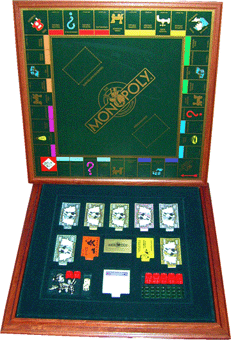 Edition:
Familien Ausgabe (Family edition) Edition:
Familien Ausgabe (Family edition)
Publisher: Franklin Mint - 1994
Dimensions of the table: 7.5 x 52.5 x 52.5 cm
The game:
This edition is from the collection of Roland Klose - D. (Diese Version auf deutsch:
www.monopoly-wiki.de).
July 2009 I was informed by Steve Kahan he had a copy of a poor
version of the Franklin Mint edition, called the Player's
edition. Soon afterwards however, Roland informed me he has a copy of
the German version. And indeed, this Familien Ausgabe is as simple and
poor, shown a.o. by:
 | The set consists of a wooden bottom section, for the
storage of the accessories and a wooden top section, being the game
board
of this edition. Although the picture gives the impression the play-field to be green felt-lined
nothing is less true.
The surface is but plastic with printed text. |
 |
The 10 tokens are of simple pewter. They are resp.:
ship - cannon - iron - lantern - shoe - purse - race car - rocking horse
-
thimble and top hat. These are re-creations of the original 1935 edition
"charms". |
 |
The banknotes are specially made for this Family Edition.
The currency is in Deutsche "Marks" (ought to be "Mark")
but with the
addition "Monopoly Währung". The bills show Uncle Pennybags (because
lack of the colored bow tie) and no walking stick. |
 |
The houses and hotels
do have the special Franklin Mint designed shapes but they are made of red
and blue green plastic. |
On the other hand: 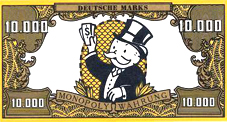
 |
the
Chance and Community Chest
cards are as nice as those of the Collector's edition and have
therefore all funny
illustrations with Uncle Pennybags. |
 |
the property deeds are the same, although without a
"Real Estate Portfolio". |
This copy is without a pedestal, nor a glass cover or
Millionair's chairs.
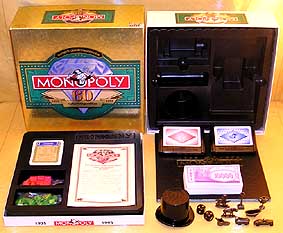 Edition: Gold box
60 years Edition: Gold box
60 years
Publisher: Parker/Tonka/Hasbro - 1995
Dimensions of the box: 11.5 x 29.8 x 29.8 cm
The game:
The gold colored box shows a nice illustration of a diamond on a green
background on the cover and all its flanks as well as all flanks of the white
inner box. Over the diamond is the red bar
with Monopoly and Uncle Pennybags as well as a gold banner saying "1935
GEBURTSTAGS- EDITION 1995". The board is folded in four, it has a
black back and a marble colored game side. The "limitation" of this
edition is shown by a sticker with number on the game side of the board.
The nicely printed bottom of the box shows:
 |
Uncle Pennybags' hat, to be used as a shaking-box. |
 |
5 of the 8 "antique bronze" tokens of the old times, viz.
Uncle
Pennybags -Tram - Car - Shoe - Elephant - Bathtub - Candlestick and Beaker. |
 |
The black plastic tray (in shallow box) for the banker's money. This
holder is placed on top of the
2nd black plastic tray that contains the shaking-box and the 2 trays for the
Ereignis and Gemeinschafts cards. |
 |
Some of the luxury title deed carts and banknotes. |
The game was manufactured in …. Great Britain.
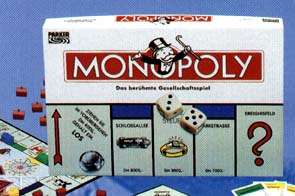 Edition: Standard,
Ref. 14535D Edition: Standard,
Ref. 14535D
Publisher: Parker/Tonka/Hasbro - 1996
Dimensions of the box: 26.8 x 40.3 x 5.3 cm
of the double folded board: 25.2 x 25.2 cm
The game:
This edition is a sample of the "new look" of the games who are manufactured
in the Irish works. The fresh white box shows a red
bar and a part of the fourth side of the board on the cover. The width and the
length of the boxes are standardized for all of their games Hasbro told me. So
herewith the long box we called standard so far disappeared.
This new box contains a red plastic tray
insert with newly shaped slots for the banknotes and title cards of the banker.
The board is folded in four like in the so-called "small box".
The back side is red and the play side is blue
green. The set is manufactured in Ireland and so it has again a
picture of a "laughing family" at the back of the box. On the board
are the nice Ereignis- and Gemeinschaftskarten of this game. The banknotes
are of the new model, i.e. with a black Monopoly banner and Uncle Pennybags in
the upper part of the circle and, almost unvisible, the remark "1996 Tonka
Corporation".
The 10 tokens are of pewter and likely no longer manufactured in China.
The green, plastic houses do have a
chimney, the red hotels don't.
The price of this set amounted to DM 50.- (=US$ 30.-) in Januari 1998.
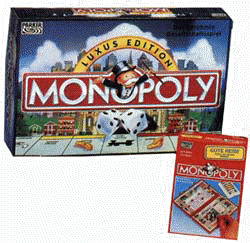 Edition: Monopoly
Luxus Edition, Ref. 14549 Edition: Monopoly
Luxus Edition, Ref. 14549
Publisher: Parker Bros./Hasbro - 1997
Dimensions of the box: 26.8 x 40.3 x 8.8 cm
of the double folded board: 25.2 x 25.2 cm
The game:
Again a great issue of "the famous party game". The box has the same
length and width sizes as the one of the "standard" edition, in
contrast to the American Deluxe edition, of which the box is still long.
Unfortunately both these boxes are rather vulnerable, but the content is well
taken care of: In the box are, besides the solid game board (with dark
blue back) a soft plastic insert with 4 trays for the houses and
hotels, but in particular the never before used "Banker's Tray",
a well shaped money-and cards-holder of solid blue
plastic. You have to put the separate stickers on both this tray as well as the
2 separate card holders (for the Chance and Community Chest cards) yourself. The
clear color picture at the bottom of the box gives a good total impression of
the set.
This time the lid shows the third side of the game board, so with the
properties Theaterstrasse, Museumstrasse, Opernplatz - Nordbahnhof -
Lessingstrasse, Schillerstrasse and a part of the tap, on which 2 of the 10
gold colored tokens are to be seen!
The houses and hotels are made of nice glossy wood. The banknotes
are the same as those of the "standard" edition.
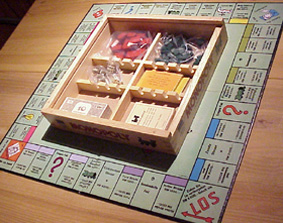 Edition:
Wood box with 1957 engine, Ref.40753/100 Edition:
Wood box with 1957 engine, Ref.40753/100
"mit dem Originalspielbrett aus 1935!"
(with
the original game board of 1935!)
Publisher: Parker Brothers/Hasbro - June 2003
Dimensions of the box: 5.3 x 26.3 x26.3 cm
The game:
This "nostalgic" version with locomotive of the 1957 American edition
has also been published in many other countries but Germany took this
opportunity to show again the original version
with the streets of Berlin.
On the bottom of the box it is said a.o.:
" .... National editions of this game show the streets
and stations of the concerning capital cities. So it was the case with the
first German version with street names of Berlin, until is was forbidden by
the Nazies in 1936. Afterwards a new version was introduced and this time the
property names came from a ficticious city. So the foundations were led for a
generally believed superstition that a "Badstraße" is sooner found
in a poor area, while a
"Schlossallee" is where the rich live. ..."
It looks like Hasbro-Deutschland
is going to put the helm over (like the publisher of the South African
edition did in 2003) and is going to use this version in the future for the
standard editions instead of the generally occuring meaningless street names. For
the rest the design of this issue is again a jumble of as well Waddingtons
as Parker
Brothers:
 | The game board's midfield shows Waddington's well-known
"locomotives illustration" from the 40's and 50's. |
 | On the station spaces are the green,
backwards driving Waddington engines. |
 | On the lid is the Parker Brothers engine of their 1957
edition. |
 | The stations' property deeds show the black Parker
Brothers engine. |
 | The Ereignis- and Gemeinschaftskarten
are, like those in all early Waddington editions, orange
and yellow
cards but with sharp corners. |
Identical to the original issue this edition has 8 banknotes, indeed according to the original design with different figures
and in Reichsmark. The notes are resp.: 10 - 20
- 100 - 200
- 400
- 1000 - 2000
and 10000.
The green huouses and high, red
hotels are of timber. The 6 bronze colored metal tokens
are: hat - racing car - shoe - thimble - dog and an engine-with-shover.
Both small (11 mm) dice are ivory colored and have black pips.
This carefully manufactured edition was made in China. (Also
see the Original 1936 issue as well as the1982 Replica version.) |